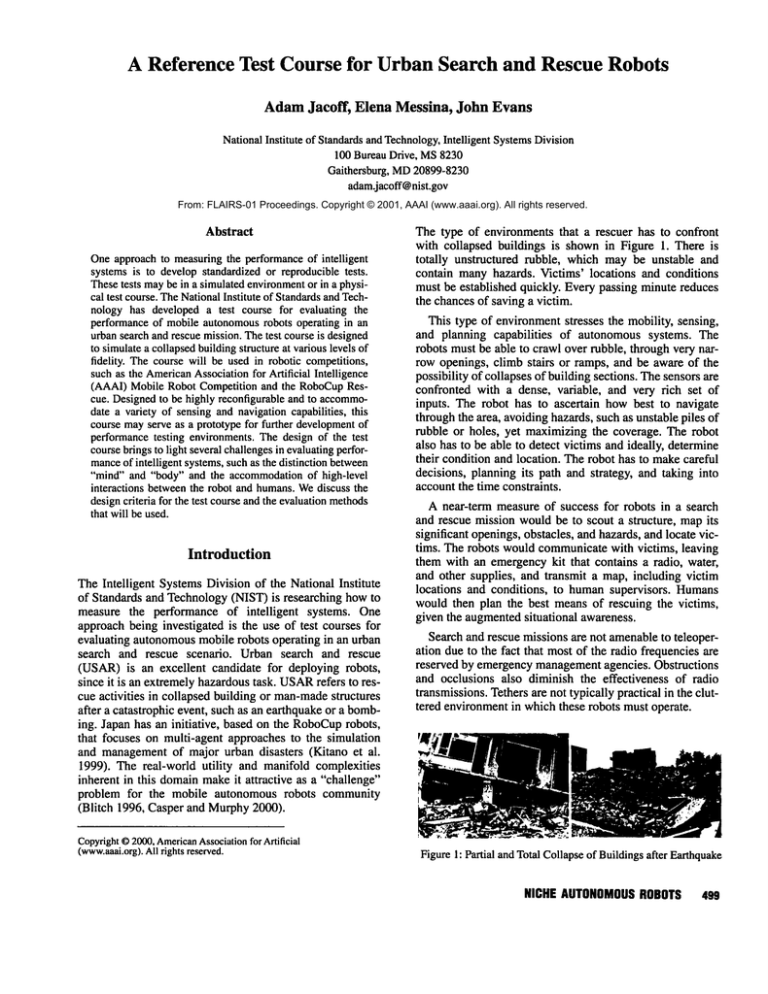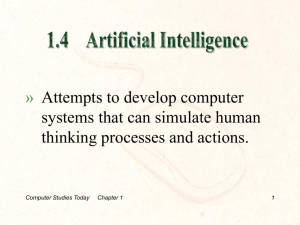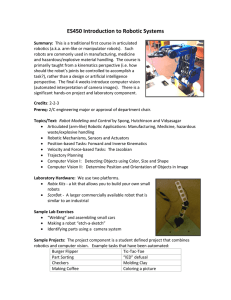
A Reference Test Course for UrbanSearch and Rescue Robots
AdamJacoff, Elena Messina, John Evans
NationalInstitute of Standardsand Technology,
Intelligent SystemsDivision
100 BureauDrive, MS8230
Gaithersburg, MD20899-8230
adam.jacoff@
nist.gov
From: FLAIRS-01 Proceedings. Copyright © 2001, AAAI (www.aaai.org). All rights reserved.
Abstract
Oneapproachto measuringthe performanceof intelligent
systemsis to developstandardizedor reproducibletests.
Thesetests maybe in a simulatedenvironment
or in a physical test course.TheNationalInstitute of StandardsandTechnology has developeda test course for evaluating the
performanceof mobileautonomousrobots operating in an
urbansearch andrescue mission.Thetest courseis designed
to simulatea collapsedbuildingstructureat variouslevels of
fidelity. Thecoursewill be used in robotic competitions,
suchas the American
Associationfor Artificial Intelligence
(AAAI)MobileRobot Competition and the RoboCupRescue. Designedto be highly reconfigurableand to accommodate a variety of sensingand navigationcapabilities, this
coursemayserve as a prototypefor further development
of
performancetesting environments.The design of the test
coursebringsto light severalchallengesin evaluatingperformanceof intelligent systems,suchas the distinction between
"mind"and "body" and the accommodation
of high-level
interactions betweenthe robot and humans.Wediscuss the
designcriteria for the test courseand the evaluationmethods
that will be used.
Introduction
The Intelligent SystemsDivision of the National Institute
of Standards and Technology(NIST) is researching how
measure the performance of intelligent
systems. One
approach being investigated is the use of test courses for
evaluating autonomousmobile robots operating in an urban
search and rescue scenario. Urban search and rescue
(USAR)is an excellent candidate for deploying robots,
since it is an extremelyhazardoustask. USAR
refers to rescue activities in collapsed building or man-made
structures
after a catastrophic event, such as an earthquakeor a bombing. Japan has an initiative, based on the RoboCup
robots,
that focuses on multi-agent approaches to the simulation
and managementof major urban disasters (Kitano et al.
1999). The real-world utility and manifold complexities
inherent in this domainmakeit attractive as a "challenge"
problem for the mobile autonomous robots community
(Blitch 1996, Casper and Murphy2000).
Copyright
©2000,American
Association
for Artificial
(www.aaai.org).
Allrightsreserved.
The type of environments that a rescuer has to confront
with collapsed buildings is shown in Figure 1. There is
totally unstructured rubble, which may be unstable and
contain manyhazards. Victims’ locations and conditions
must be established quickly. Every passing minute reduces
the chances of saving a victim.
This type of environmentstresses the mobility, sensing,
and planning capabilities of autonomous systems. The
robots must be able to crawl over rubble, through very narrow openings, climb stairs or ramps, and be aware of the
possibility of collapses of building sections. The sensors are
confronted with a dense, variable, and very rich set of
inputs. The robot has to ascertain how best to navigate
through the area, avoiding hazards, such as unstable piles of
rubble or holes, yet maximizingthe coverage. The robot
also has to be able to detect victims and ideally, determine
their condition and location. The robot has to makecareful
decisions, planning its path and strategy, and taking into
account the time constraints.
A near-term measure of success for robots in a search
and rescue mission wouldbe to scout a structure, mapits
significant openings, obstacles, and hazards, and locate victims. The robots would communicatewith victims, leaving
them with an emergencykit that contains a radio, water,
and other supplies, and transmit a map, including victim
locations and conditions, to humansupervisors. Humans
would then plan the best means of rescuing the victims,
given the augmentedsituational awareness.
Search and rescue missions are not amenableto teleoperation due to the fact that most of the radio frequencies are
reserved by emergencymanagementagencies. Obstructions
and occlusions also diminish the effectiveness of radio
transmissions.Tethers are not typically practical in the cluttered environmentin whichthese robots must operate.
Figure1: Partial and TotalCollapseof Buildingsafter Earthquake
NICHEAUTONOMOUS
ROBOTS499
USARas a Robotic Challenge
A search and rescue mission is extremely challenging and
dangerousfor humanexperts. This is a highly unstructured
and dynamicenvironment, where the mission is time critical. Verylittle a priori informationabout the environmentor
building mayexist. If any exists, it will almost certainly be
obsolete, due to the collapse.
Urbansearch and rescue is therefore attractive as a mission frameworkin whichto measureintelligence of autonomous robots. The high degree of variability
and
unpredictability demandhigh adaptation and sophisticated
decision-makingskills from the robots. Robots will need to
quickly and continually assess the situation, both in terms
of their ownmobility and of the likelihood of locating more
victims. USARmissions are amenable to cooperation,
which can be considered another higher-level manifestation
of intelligence. Wepropose that any robot or team of robots
that is able to successfully and efficiently carry out USAR
missions would be considered intelligent by most standards.
In the following sections, we will briefly discuss how
USARmissions tax specific componentsof an intelligent
system.
Mobility
As can be seen in Figure 1, the mobility requirements for
search and rescue robots are challenging. Theymust be able
to crawl over piles of rubble, up and downstairs and steep
ramps, through extremely small openings, and take advantage of pipes, tubes, and other unconventional routes. The
surfaces that they must traverse maybe composedof a variety of materials, including carpeting, concrete blocks,
wood, and other construction material. The surfaces may
also be highly unstable. The robot maydestabilize the area
if it is too heavyor if it bumpssomeof the rubble. There
maybe gaps, holes, sharp drop-offs, and discontinuities in
the surfaces that the robot traverses.
Sensing
In order to be able to explore USAR
sites and successfully
navigate in this environment, the robot’s sensing and perception must be highly sophisticated. Lighting will be variable and maybe altogether missing. Surface geometryand
materials mayabsorb emitted signals, such as acoustic signals, or they mayreflect them. For truly robust perception,
the robots should emulate humanlevels of vision.
The presence of victims may be manifested through a
variety of signals. The stimuli that the robots have to be
prepared to process include:
¯ Acoustic - victims maybe calling out, moaningsoftly,
knocking on walls, or otherwise generating sounds.
There will be other noises in the environment due to
shifting materials or comingfrom other USAR
entities.
¯ Thermal- a victim will emit a thermal signature. There
maybe other sources of heat, such as radiators or hot
water.
600
FLAIRS-2001
Visual - a multiplicity of visual recognition capabilities,
based on geometric, color, textural, and motion characteristics, will be exercised. Recognizinghumancharacteristics,
such as limbs, color of skin, clothing is
important. Motion of humans, such as waving, must be
detected. Confusing visual cues may comefrom wallpaper, upholstery or curtain material, strewn clothing, and
movingobjects, such as curtains blownby a breeze.
Knowledge Representation
In order to support the sophisticated planning and decisionmakingthat is required, the robot must be able to leverage a
rich knowledgebase. This entails both a priori expertise or
knowledge,such as howto characterize the traversability of
a particular area, as well as gained information, such as a
mapthat is built up as it explores. It must develop rich
three-dimensional spatial mapsthat contain areas it, or
other robots, have and haven’t yet seen, victim and hazard
locations, and potential quick exit routes. The mapsfrom
several robots mayneed to be shared and merged.
A variety of types of knowledgewill be required in order
to successfully accomplishsearch and rescue tasks. Higherlevel knowledge, which maybe symbolic, includes representations of what a "victim" is. This is a multi-facetted
definition, which includes the manymanifestations that
imply a victim’s presence.
Planning
Anindividual robot must be able to plan howto best cover
the areas it has been assigned. The time-critical nature of
its work must be taken into account in its planning. It may
need to trade off betweendelving deeper into a structure to
find more victims and finding a shortcut back to its human
supervisors to report on the victims it has already found.
Autonomy
As mentionedabove, it is not currently practical to assume
that the robots will be in constant communicationwith
humansupervisors. Therefore, the robots must be able to
operate autonomously, making and updating their plans
independently. In somecircumstances, there maybe limited-bandwidth communicationsavailable. In this case, the
robots may be able to operate under a mixed-initiative
mode, where they have high-level interactions
with
humans. The communicationsshould be akin to those that a
humansearch and rescue worker may have with his or her
supervisor. It definitely wouldnot be of a teleoperative
nature.
Collaboration
Search and rescue missions seem ideally suited for deploying multiple robots in order to maximizecoverage. Aninitial strategy for splitting up the area amongstthe robots
maybe devised. Oncethey start executing this plan, they
will revise and adapt their trajectories based on the conditions that they encounter. Information sharing betweenthe
robots can improvetheir efficiency. For example,if a robot
detects that a particular passagewaythat others mayneed to
use is blocked, it wouldcommunicate
that to its peers. The
robots should therefore collaborate and cooperate as they
jointly perform the mission. They maybe centrally or decentrally controlled. The robots themselves may all have
the same capability, or they maybe heterogeneous, meaning that they have different characteristics. Heterogeneous
robot teams may apply the marsupial approach, where a
larger robot transports smaller ones to their workareas and
performs a supervisory function.
Measuring
the
Performance
of USAR Robots
Wehave described briefly the requirements for autonomous
urban search and rescue robots. Wewill now discuss
approaches to testing their capabilities in achieving USAR
missions.
The approach being taken by the USARrobot competitions that use the NISTtest course are based on a point system. The goal of the robots is to maximizethe numberof
victims and hazards located, while minimizing the amount
of time to do so and the disruption of the test course.
Specifically, the AAAIMobileRobotcompetition (http://
www.alc.nrl.navy.mil/~schultz/aaal2000) will use Olympic-style scoring. Eachjudge will have a certain numberof
points that can be awardedbased on their measuringcertain
quantitative and qualitative metrics.
Robotsreceive points for:
¯ Numberof victims located
¯ Numberof hazards detected
¯ Mappingof victim and hazard locations
¯ Staying within time limits
¯ Droppingoff a packageto victims representing first aid,
a radio, or food and water
¯ Quality of communications with humans
¯ Tolerance of communicationsdropout
Robotslose points for:
¯ Causing damageto the environment, victims, or tbemselves (e.g., destabilizing a structure)
¯ Failing to exit within time limits
In certain sections of the test course, robots are allowed
to have high-level communications with humans. These
communicationsmust be made visible to the judges. Metrics for evaluating the quality of the communication
include
"commands" per minute and/or bandwidth used. Fewer
commands per minute and less bandwidth per minute
receive better scores. Tolerance of communicationsdisruption is an importantcapability and will be given greater difficulty weighting. A team may request that the judges
simulate communicationdisruptions at any point in order
that the robots demonstrate howto recover. Examplesof
recovery wouldbe to moveto a location wherethere is better chance of communication, making decisions autonomously instead of consulting humans, or utilizing
companionrobots to relay the information to the humans.
For teams consisting of multiple robots, the advantageof
cooperating or interacting robot must be demonstrated. This
can be either in performingthe task better, or performing
the task more economically. Multi-robot teams should have
a time speedupthat is greater than linear, or maybe able to
perform the tasks with less overall power consumptionor
cost. The scoring will factor in the numberof robots, types
of robots, types or mixture of sensors, etc., in determining
the performanceof a team.
The RoboCup Rescue competition (http://www.robocup.org/games/36.html), sponsored by Robot World Cup
Initiative, takes an evaluation benchmarkingapproach. Initially, there are three benchmark
tasks. The current tasks are
victim search, victim rescue, and a combination of victim
search and rescue. Additional ones will be added as the
competition and participants evolve. The RoboCupRescue
includes a simulation infrastructure in which teams can
compete,as well as the use of the NISTtest course.
Figure2: NIST’sReferenceTest Courseas used for the AAAI
2000MobileRobotCompetition
NICHE AUTONOMOUS
ROBOTS 501
Their evaluation metrics are still under development.
Examplesof criteria that have been published on their web
site include:
¯ Recoveryrate, expressed as percentage of victims identified versus numberunder the debris.
¯ Accuracy rate, computed as the number of correctly
identified victims divided by the total numberof identified victims.
¯ Operational loading, which is the numberof operations
that a humanhas to perform in order to enable to robots
to performtheir tasks.
¯ If rescuing victims, the total time it takes to rescue all
victims.
¯ Total damagecaused to victims in attempting to rescue
them.
The Test Course Design
The test course that NIST designed for the AAAIMobile
Robot Competition (Figures 2 and 3) was designed with
three distinct areas of increasing difficulty designated the
Yellow, Orange and Red Courses. Overall, the course is
meant to represent several of the sensing, navigation, and
mappingchallenges that exist in a real USAR
situation. As
discussed above, these are challenges that correlate well
with general characteristics desirable in mobile, autonomousrobots that mayoperate in other types of missions. In
the design of the course, trade-offs were made between
realism and reproducible, or controlled, conditions. In order
to be able to evaluate the performanceof robots in specific
skill areas, certain portions of the course maylook unrealistic or too simplified. This idealization is necessaryin order
to abstract the essential elements being exercised, such as
the ability to deal with a particular sensing challenge.
Giventhe controlled conditions the test course provides,
it is possible to havemultiple robots or teamsface the identical course and have their performances compared. This
should yield valuable information about what approachesto
robotic sensing, planning, and world modeling work best
under certain circumstances.
The course is highly modular, allowing for reconfiguration before and during a competition, Judges may swap
wall panels that are highly reflective for somethat are fabric-covered, for example, or victims maybe relocated. This
reconfigurability can serve to avoid having robot teams
"game"the course, i.e., programtheir robots to have capabilities tailored to the course they’ve seen previously. The
reconfigurability can serve to provide morerealism as well.
A route that the robot used previously may become
blocked, forcing the robot to have to find an alternative
way.
The three areas of the course are described below. A representative layout of the entire course is shownin Figure 3
without the added visual complexity, textures, debris and
targets the robots must cope with during competition. The
entire course covers roughly 400 square meters (20 m. x 20
m.). Notethat the use of color in the namesof the section is
for labeling purposes only and does not mean that the
courses are primarily colored in their namesakecolor.
Figure 3: CAD
Viewof the "lest CourseLayout
502
FLAIRS-2001
Yellow Course
Giventhe fact that participating teams,at least initially, are
primarily from universities that maynot have access to new
agile robotic platforms, one design requirement was to have
an area within the course wherethe mobility challenges are
minimal.Wecall this area the "Yellow"course, and it is the
easiest course to maneuver in. The floor of the Yellow
course is fiat and continuous. Passagewaysare wide enough
to permit large robots, up to about i meter diameter, to pass
easily.
Yet the Yellow course allows teams with sophisticated
perception and planning to exercise their robots’ capabilities. Somesensing challengesare as difficult in this section
as in the others. Thereis highly reflective and highly absorbent material on the walls. Certain wall panels are clear
Plexiglas, whereasothers are covered in brightly patterned
wallpaper. Someareas are dimly lit or accessible only from
one direction. Victimsare representedin all modalities (i.e.,
acoustically, visually, through motion, thermally, etc.) and
are hidden from view under furnishings or in closed areas.
Orange Course
The Orangecourse is of intermediate difficulty. A second
story is introduced extending the mazeparadigmto three
dimensions. Andthere are routes that only smaller robots
maypass through. The robots have to climb stairs or a ramp
in order to reach victims. Flooring materials of various
kinds, such as carpeting, tile, and rubber, are introduced.
Hazards, such as holes in the floor, exist. In order to be
effective, the robot has to plan in a three-dimensionalspace.
Larger robots are be able to navigate through someportions
of this course, but not all.
would be best suited in marsupial configurations in this
area.
Conclusion
An Urban Search and Rescue application for autonomous
mobile robots poses several challenges that can be met only
by highly intelligent, mobilesystems. Thevariability, risk,
and urgency inherent in USARmissions make this a good
framework in which to begin measuring performance in
controlled and reproducible situations. Webelieve that the
test course we are developingcan serve to elucidate performancemeasures for overall systems, as well as for components of intelligent systems.
Acknowledgments
The development of the USARtest course was carried out
with the support from the Defense Advanced Research
Agency (DARPA) Mobile Autonomous Robot Software
Program and the Naval Research Laboratory.
References
Kitano, H. et al. 1999. RoboCupRescue: Search and Rescue in Large-Scale Disasters as a Domainfor Autonomous
Agents Research. In Proceedings of the IEEE Conference
on Man, Systems, and Cybernetics.
Blitch, J. 1996. Artificial Intelligence Technologies for
Robot Assisted Urban Search and Rescue," Expert Systems
with Applications, Vol. 11, No. 2, pp. 109-124, 1996.
Casper, J., and Murphy,R.R. 2000. Issues in Intelligent
Robots for Search and Rescue. In proceedings of the SPIE
GroundVehicle TechnologyII Conference. Orlando, FL.
Red Course
The Redcourse poses the most realistic representation of a
collapsed structure. Wedo not anticipate that any of the
contestants will be able to autonomouslynegotiate the Red
course in the next couple of years. However,this section
provides a performancegoal for the teams to strive for. In
the Redsection, piles of rubble abound,lighting is minimal
or non-existent in areas representing so-called "pancake
collapses," and passagewaysare very narrow. The course is
highly three-dimensional, from a mapping perspective.
There are multiple floors which are surrounded by rubble
piles that the robot has to traverse. All these features needto
be mapped.Passagewaysunder the rubble or through pipes
have to be negotiated by the robots to reach certain areas or
to get closer to victims. There are someportions of this
course that can be traversed by the larger robots, but they
are not be able to reach most of the victims. Larger robots
NICHE AUTONOMOUS
ROBOTS 503


